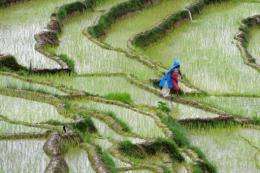Gene breakthrough could boost rice yields by 20 percent

Scientists on Wednesday said they had developed a strain of rice that grows well in soils lacking the nutrient phosphorus, a feat that could boost crop yields for some farmers by as much as a fifth.
The announcement ends a quest to pinpoint a mystery gene that helps the roots of baby rice plants tease phosphorus from the soil, enabling them to notch up strong, early growth.
The gene has now been transferred to modern varieties of rice using classic methods of cross-breeding, not genetic engineering, said Sigrid Heuer at the International Rice Research Institute (IRRI) in the Philippines.
Next week, national rice breeders from Bangladesh, India, Thailand and India will be briefed on the exciting find, which should benefit small farmers most of all, Heuer said in a phone interview from Manila.
"I would expect to see (an improvement in yield of) around 20 percent, but it depends so much on the type of the soil and how severe the stress is," Heuer said.
"But realistically, we are talking conservatively of an average of 10-20 percent, and locally a little more if the (phosphorus) stress is severe," she said.
The breakthrough seeks to address one of the biggest problems facing rice growers from the southeastern United States to South America, Southeast Asia and China.
Many soil types bond tightly to phosphorus, surrendering only a tiny amount of the precious mineral to plant roots.
To get around this, farmers look to phosphorus fertilisers which are spread on the field.
But in poorer countries, this option is often too costly, which means the plant is left undernourished at a stage when it is in competition with weeds. Ultimately this meagre growth affects yields when the plant matures.
The search for PSTOL-1 -- for phosphorus-starvation tolerance 1 -- began in the late 1990s, when researchers were intrigued that a rice strain grown in India called Kasalath grew so well in phosphorus-deficient conditions.
But it took nearly a decade of further work, including a full sequencing of the strain's genome, to close in on the gene that does the magic.
"Over the last one-and-a-half to three years, we were pretty certain that we had the gene, but then we had to carry out a lot of experiments to confirm our findings," said Heuer.
Poor farmers, especially those in Southeast Asia and Bangladesh, could benefit most, she said.
But rice growers in richer countries could also save money as they would need less fertiliser, which would also mean less damaging phosphate runoff into groundwater and the sea.
The research, published in the journal Nature, marks the latest laboratory exploit for boosting rice yields. Other recent finds have been genes that help rice plants cope better with drought and saline soil.
Arguably the most important crop in the world, rice is under pressure from rising demographic growth and the impacts of climate change.
Last October, the UN Population Fund (UNFPA) said the global population of seven billion could rise to at least 10 billion by 2100, but could top 15 billion if birth rates are just slightly higher than expected.
Phosphate fertilisers are typically extracted from layers of rock that millions of years ago were ocean sediments.
The price of rock phosphate has more than doubled since 2007. According to a 2009 estimate, world supplies could run out in 50 to 100 years.
Journal information: Nature
(c) 2012 AFP















